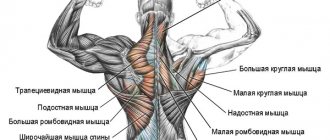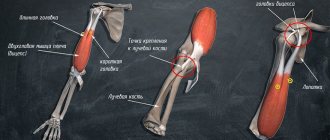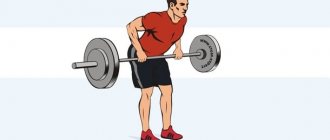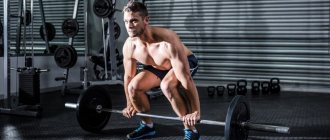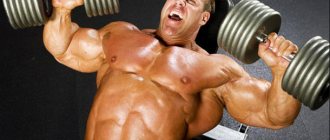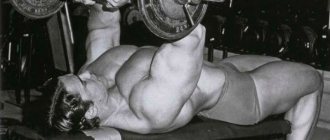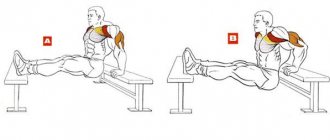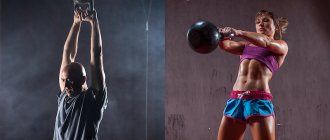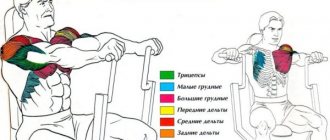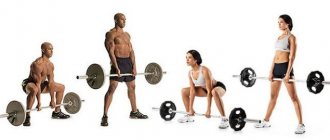The deltoids are muscles that surround the shoulder joints on all sides. Each “delta” consists of three bundles: anterior, middle, posterior. But it is the middle heads that give these muscles their rounded, athletic shape. If you want to have voluminous spherical deltoids, you need to perform special exercises with weights. Professional trainers recommend using barbell rows to the chin to develop medium fascicles. We offer a detailed analysis of the technique of this element, its advantages and variations.
Target muscles
When performing chin pulls, the athlete focuses on the middle parts of the deltoid muscles. At the same time, the following indirect loads are received: the anterior deltas, trapezius muscles, scapular and serratus muscles, and biceps. It is worth noting that medium beams are worked using standard techniques. If you slightly change the way the element is performed, you will be able to shift the emphasis of the load to the trapezoid. We'll talk more about this in the following sections.
Chin Pull: Train Your Shoulders Correctly
The chin pull is an isolation exercise. Depending on the grip, we can work on different muscle groups. Narrow placement of the arms will load the trapezius and anterior delta. Wide, will shift the emphasis to the middle and posterior deltoid. We can do chin pulls with different training equipment: a barbell, dumbbells in a Smith machine and in a block machine. Each option has a number of advantages. We will discuss them in this article. We’ll also look at some points that will help make your workout even more productive.
Execution technique
The barbell row to the chin (or, in simple terms, a pull-up) is a multi-joint element that has a complex effect on the entire shoulder girdle. But now we will analyze a technique that focuses the load specifically on the middle bundle of the deltoid muscles:
- Prepare the apparatus: throw discs onto a standard 20 kg bar and place it on the supports of the power frame for easy removal;
- Grasp the barbell with a straight closed grip. The distance between the palms is slightly wider than the shoulders;
- Remove the apparatus from the racks, sit slightly on your feet and lean forward a little. Do not round your back;
- Exhale and smoothly lift the barbell to your chest. As you inhale, slowly lower to the starting position.
Remember, the most important thing in this exercise is to “feel” the deltoids. That is, you should feel how the muscle fibers tense and a slight “burning” appears. This will indicate that the exercise is performed correctly, and the deltoids receive the load necessary for growth.
Tips and tricks
Coming to the gym for the first time, doing a perfect workout is an almost impossible task. Mistakes accompany any beginner. And you can avoid them only if you know in advance what to prepare for.
Did you know? At first, barbell rows were performed only in a snatch style, which led to an increased risk of injury. This style was not intended to build up back muscles; it was intended to help overcome the lower phase of the movement.
Common mistakes made by newbies
Most often, athletes who are faced with barbell deadlifts for the first time make several mistakes:
- Excessive weight. In this case, your body will begin to twitch, and normal lifting of the barbell will become impossible. You should not overestimate yourself, but rather remove a few weights from the barbell.
- Posture. The fact that you are lifting weights while standing already implies a straight posture. Your body position needs to be constantly monitored, so make sure your posture is correct before you begin deadlifting.
- The barbell is far from the body. The weight should seem to glide across your body as you lift and lower the bar, and your body should not lean to the sides. Otherwise, the lower back and middle deltoids will be loaded too much, which would not happen if performed correctly.
Important! For beginners, it is enough to perform 3-4 sets of 6-12 repetitions. Gradually their number can be increased.
Secrets and subtleties of implementation
The following recommendations will help you achieve the desired result:
- the body should always be level;
- The position of the elbows is of great importance - they should be located as high as possible above the bar;
- always hold the barbell at the highest point for a couple of seconds;
- the barbell must be lowered smoothly without throwing it;
- objectively evaluate the weight that is acceptable for you, otherwise the exercise will be ineffective;
- dumbbells are a good alternative to barbells; they are less traumatic;
- to hold the bar when using heavy weight, the help of straps is allowed;
- for greater load on the trapezius, you can use a narrow grip;
- a wide grip pumps up the deltoid muscles and reduces the risk of shoulder injuries;
- Before performing barbell rows, thoroughly stretch your shoulders.
Video: barbell row to the chin
This exercise is a great addition to any athlete's arsenal.
Learn how to do barbell deadlifts, barbell curls, Romanian barbell deadlifts, and bent-over barbell rows.
When used correctly, it will help you create beautiful posture and lines of the back muscles; the main thing is to treat the training responsibly and try not to make mistakes.
Advantages of wide and narrow grips
A wide grip allows you to focus on working the middle deltoids.
This is precisely the goal of most athletes who use pull-ups. In addition, placing the palms wide on the bar helps reduce the range of motion, which prevents the elbows from being raised high and protects the shoulder joints from dislocation or sprain. We can say that a wide grip is preferable for beginner athletes with weak joint ligaments and tendons. A narrow grip helps to shift the emphasis of the load on the trapezius muscle and thereby visually highlight it and make it more voluminous. It is also worth noting that narrow palm placement on the bar increases tension in the wrist and shoulder joints. Therefore, this exercise is preferable for experienced bodybuilders. For beginner athletes, instead of close-grip pull-ups, we recommend using safer shrugs with dumbbells to develop the trapezius.
Variations of broaches
Chin rows can be performed not only with a barbell, but also with other equipment and even exercise machines. Each of them has its own advantages. Let's consider the features of performing broaches with various types of weights.
EZ bar chin row
We have already said that the narrow placement of the palms on a straight barbell increases the load not only on the shoulder, but also on the wrist joints.
Because of this, an unprepared athlete may experience pain. In addition, by overstraining your wrists toward the end of each set, you are more likely to fall out of your hands, which is likely to cause serious injury. Using an EZ bar allows you to perform pull-ups with a narrow grip without overstraining the wrist joints. The effectiveness is due to the presence of bends on the projectile. This shape makes it more convenient and safe to hold the barbell. Features of the technique of broaches with an EZ bar: the body should be straight, without bending forward, and the elbows should be raised above the shoulder joints.
Pulling in a Smith machine
In this exercise, the bar moves along two guides.
This allows you to avoid some mistakes in technique, and also eliminates the small muscles responsible for stabilizing the body. As a result, the athlete focuses specifically on working the target muscles. In addition, performing pull-ups in the Smith machine helps a beginner learn the correct technique of the element. Experienced athletes use the Smith machine to recover from shoulder injuries. Since the load is fixed on the guides, instability of the projectile during lifting is eliminated. This means that the athlete can do safe stretches with light weights to pump blood into the injured joint. This method of training promotes the speedy recovery of joint ligaments and muscles.
Chin row with dumbbells
Since there is no single support in the form of a bar between the arms, the small muscles responsible for stabilization and balance receive additional stress.
This helps to better develop the core. In addition, the advantages of using dumbbells include more comfortable holding - such equipment can be slightly turned when lifting. This reduces dangerous tension in the wrist joints. The technique as a whole is no different from the standard one with a bar: to develop the deltoid muscles, use a wide position of dumbbells and a slight bend forward; to work the trapezius, use a narrow hold of dumbbells and a vertical stand without bending. All the features and recommendations presented for barbell rows also apply to dumbbell rows.
Broach on the lower crossover block
When performing pull-ups to the chin in a block simulator, it is permissible to use both a metal bar and a rope handle.
Thanks to this, each athlete has the opportunity to choose a projectile with a comfortable grip. Also, the advantages of using a crossover include a convenient system for quickly changing the load, which is useful when performing broaches using the drop-set principle. Professional bodybuilders note another advantage of the block exercise machine – safety. Since the load is supported on the guides, the likelihood of injury is reduced. The technique of pulling in a crossover is generally similar to training with free weights. The only condition is that you need to stand close to the lower block so that the load vector is directed specifically at the shoulder girdle.
Newbie mistakes
- First mistake. The most common beginner mistake is usually having a grip that is too narrow. Almost all “snowdrops” make this mistake, because they say that thanks to a narrow grip, the trapezius is trained with more emphasis. The theory is correct, but such a narrow grip should be slightly wider than shoulder width; it’s no longer possible! When performing the exercise with a too narrow grip, the trapezius muscles are also actively trained, but there is a very high risk of damaging the elbow joints. In such cases, the degree of risk directly depends on the weight of the barbell; the heavier it is, the significantly higher the risk.
- Second mistake. The second common mistake is heavy weights. Of course, a beginner is sometimes ashamed in front of experienced athletes, so they usually hang a bunch of weights and tear their muscles, while performing the exercise disgustingly incorrectly. In addition, when performing an exercise with a large weight, you practically forget about the deltoids, because only the trapezius is trained with a large weight.
- Third mistake. Also very common mistakes are: bringing the elbows forward, a large arch of the back and a high tempo of the exercise. If we talk about raising the shoulders and arching the back, then everything is clear, this is simply not the correct technique, because of which your muscles are not fully pumped, and besides, the load does not fall on the listed groups of muscle tissue. As for the tempo, it should not be very high; it would be ideal to raise the barbell in 2 seconds and then lower it in one breath. While performing the exercise at a given pace, your muscles are perfectly stimulated and pumped much better.

